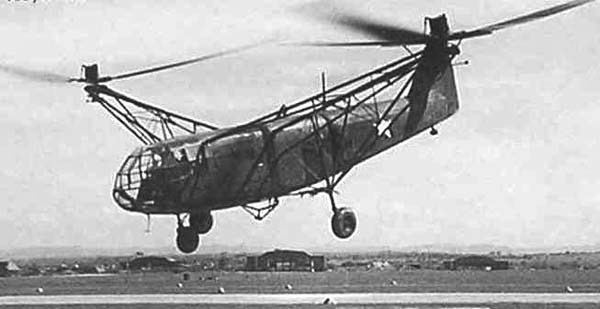Yes, you read the title right. Although the development of production helicopters is accredited to Igor Sikorsky and the US Army Air Force, Germany came very close to fielding transport helicopters in the last days of the war. Had the war continued, a scenario quite like the Vietnam war could've arisen, with helicopters being used to great effect as forwards cargo. Of course, this was never realistically possible, as the German war economy was basically gone by the point that the first helicopters were ready.
It all started with the Focke-Wulf Fw 61. Widely considered the first "practical" helicopter, it first flew in 1936. It used a novel way to cancel out rotor torque: both rotors rotated in opposing directions, and were space widely apart. It was extremely controllable, allowing test pilot Hanna Reitsch to demonstrate the aircraft
indoors at a sports stadium in Berlin. While this design was sound, it had a couple of small problems that Professor Focke wanted to solve. The design was a bit too small to be useful, and the big tubular aluminium frame holding the rotors up was not aerodynamic.
 |
| The Fw 61 flying indoors. Note that this is a legitimate aircraft, mot a small model |
Around this time another German engineer, Anton Flettner, approached the problem from a different direction. He mounted both rotors so that they overlapped in flight, using an innovative gearbox to prevent them from hitting each other. This resulted in the Fletner Fl 265, the first 'synchrocopter' and one of the silliest-looking aircraft of all time.
 |
| Note how the rotor blades overlap as they turn, and just how stupid this thing looks |
This little helicopter worked well enough (and was the safest helicopter of its time), but that wasn't good enough for Flettner. He therefore developed the improved Fl 282
Kolibri (hummingbird). This little machine used the same inter-meshing rotor arrangement of the 265 but with a better engine and more streamlining. The Kreigsmarine was impressed by the prototypes, and ordered 15. Depending on who you ask, this makes the Kolibri the first production helicopter. Repeated tests were conducted from the rear deck of the cruiser
Koln in 1941, and they were used for transporting supplies and submarine spotting. Later in the war, the army decided to convert a few of these to artillery-spotters, a role in which they proved well suited. This marked another first for WWII - First war to have helicopters used in combat.
 |
| Could they have built a smaller landing pad? |
 |
| One of the 45-ish built was captured and tested by the US Army after the war. |
This brings us to the penultimate German helicopter: the Focke-Achgelis Fa 223
Drache (Dragon). It was the result of years of research on helicopter design. It used the same rotor arrangement as the Fw 61, but scaled up. The 160 horsepower Bramo engine was replaced with a 1000 horsepower engine from the same manufacturer. The air-frame was scaled up, and the engine moved to the middle of the fuselage to make room for a cargo compartment. This design proved very reliable and workable. Had it been produced in greater quantities, it's 1000kg cargo capacity would've been very useful to the German Army. Only 20 were built, however, before production was shut down to make room for more pressing things. During trials, the Fa 223 prototype proved it tactical usefulness by airlifting out big of a crashed Doriner 217. The first helicopter sent up into the mountains to the crash site also crashed. So it was then decided to sent another one to recover the wreckage of both the plane and the helicopter. The
Drache was extremely stable, which allowed it to airlift large pieces of fuselage and even half of a wing! This was the first 'search and rescue' operation ever done by helicopter, and the Air Ministry learned many valuable lessons about helicopters through this operation. They weren't able to use those lessons, however, due to the state of Germany in 1945. After VE-day, one of the 223's was flown across the English Channel to Britain, making the first cross-channel flight by helicopter. All in all, the German helicopter program had its merits, but by the time helicopters were tactically useful it was too late to turn the tide of war.
 |
| Fa 223 V11 lining up to land during mountain trials |
 |
| Another Drache during US Army trials after the war |
And as if you haven't seen enough ancient helicopters, here's a video of
Drache trials:





1 comment:
Its really impressive how the technology developed over time and the improvements shown. I can imagine how much benefits came from all this improvement
Post a Comment